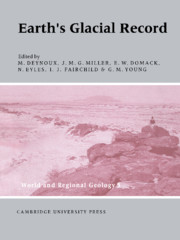Book contents
- Frontmatter
- Contents
- List of contributors
- Preface
- Acknowledgements
- 1 Geodynamic controls on glaciation in Earth history
- 2 Glacial-marine facies in a continental rift environment: Neoproterozoic rocks of the western United States Cordillera
- 3 The Neoproterozoic Konnarock Formation, southwestern Virginia, USA: glaciolacustrine facies in a continental rift
- 4 Glaciogenic deposits of the Permo-Carboniferous Dwyka Group in the eastern region of the Karoo Basin, South Africa
- 5 Itararé Group: Gondwanan Carboniferous-Permian of the Paraná Basin, Brazil
- 6 The interpretation of massive rain-out and debris-flow diamictites from the glacial marine environment
- 7 Neoproterozoic tillite and tilloid in the Aksu area, Tarim Basin, Uygur Xinjiang Autonomous Region, Northwest China
- 8 Lithology, sedimentology and genesis of the Zhengmuguan Formation of Ningxia, China
- 9 Architectural styles of glacially influenced marine deposits on tectonically active and passive margins
- 10 Marine to non-marine sequence architecture of an intracratonic glacially related basin. Late Proterozoic of the West African platform in western Mali
- 11 The enigmatic Late Proterozoic glacial climate: an Australian perspective
- 12 Isotopic signatures of carbonates associated with Sturtian (Neoproterozoic) glacial facies, central Flinders Ranges, South Australia
- 13 Reactive carbonate in glacial systems: a preliminary synthesis of its creation, dissolution and reincarnation
- 14 A Permian argillaceous syn- to post-glacial foreland sequence in the Karoo Basin, South Africa
- 15 A palaeoenvironmental study of black mudrock in the glacigenic Dwyka Group from the Boshof-Hertzogville region, northern part of the Karoo Basin, South Africa
- 16 Late Paleozoic post-glacial inland sea filled by fine-grained turbidites: Mackellar Formation, Central Transantarctic Mountains
- 17 Ice scouring structures in Late Paleozoic rhythmites, Paraná Basin, Brazil
- 18 Soft-sediment striated surfaces and massive diamicton facies produced by floating ice
- 19 Environmental evolution during the early phase of Late Proterozoic glaciation, Hunan, China
10 - Marine to non-marine sequence architecture of an intracratonic glacially related basin. Late Proterozoic of the West African platform in western Mali
Published online by Cambridge University Press: 06 July 2010
- Frontmatter
- Contents
- List of contributors
- Preface
- Acknowledgements
- 1 Geodynamic controls on glaciation in Earth history
- 2 Glacial-marine facies in a continental rift environment: Neoproterozoic rocks of the western United States Cordillera
- 3 The Neoproterozoic Konnarock Formation, southwestern Virginia, USA: glaciolacustrine facies in a continental rift
- 4 Glaciogenic deposits of the Permo-Carboniferous Dwyka Group in the eastern region of the Karoo Basin, South Africa
- 5 Itararé Group: Gondwanan Carboniferous-Permian of the Paraná Basin, Brazil
- 6 The interpretation of massive rain-out and debris-flow diamictites from the glacial marine environment
- 7 Neoproterozoic tillite and tilloid in the Aksu area, Tarim Basin, Uygur Xinjiang Autonomous Region, Northwest China
- 8 Lithology, sedimentology and genesis of the Zhengmuguan Formation of Ningxia, China
- 9 Architectural styles of glacially influenced marine deposits on tectonically active and passive margins
- 10 Marine to non-marine sequence architecture of an intracratonic glacially related basin. Late Proterozoic of the West African platform in western Mali
- 11 The enigmatic Late Proterozoic glacial climate: an Australian perspective
- 12 Isotopic signatures of carbonates associated with Sturtian (Neoproterozoic) glacial facies, central Flinders Ranges, South Australia
- 13 Reactive carbonate in glacial systems: a preliminary synthesis of its creation, dissolution and reincarnation
- 14 A Permian argillaceous syn- to post-glacial foreland sequence in the Karoo Basin, South Africa
- 15 A palaeoenvironmental study of black mudrock in the glacigenic Dwyka Group from the Boshof-Hertzogville region, northern part of the Karoo Basin, South Africa
- 16 Late Paleozoic post-glacial inland sea filled by fine-grained turbidites: Mackellar Formation, Central Transantarctic Mountains
- 17 Ice scouring structures in Late Paleozoic rhythmites, Paraná Basin, Brazil
- 18 Soft-sediment striated surfaces and massive diamicton facies produced by floating ice
- 19 Environmental evolution during the early phase of Late Proterozoic glaciation, Hunan, China
Summary
Abstract
Elementary stratigraphic events, or parasequences, are generally understood as progradational events bounded by flooding surfaces. Major sediment accumulation and preservation occur during baselevel fall. Baselevel rise is recorded in the marine environment by a veneer of sediments that is generally neglected. Field evidence from the Late Proterozoic glacially related deposits of the West African craton suggests that this concept must be revised to be applied to a continental–marine transitional zone.
Strata deposited during periods of both baselevel fall and baselevel rise, and their volumetric proportions, vary as a function of their paleogeographic position relative to the shoreline. Accordingly, an elementary building block, or depositional genetic unit is defined (Fig. 10.5). It is composed of three kinds of architectural elements bounded by four kinds of erosional or non-depositional regionally correlative surfaces. Each architectural element (Ae) corresponds to a typical association of facies, which allow the distinction of a ‘progradational wedge’ (Ae1) made up of lower to upper shoreface wave- to storm-dominated shales and sandstones, a ‘continental wedge’ (Ae2) mostly composed of non-marine rocks comprising ephemeral fluvial deposits, eolian sand sheet and dune deposits, and lagoonal to backshore sandy or carbonaceous deposits, and a ‘transgressive wedge’ (Ae3) made up of high-energy, upper shoreface, clean, well-sorted sandstones. The distinction of the bounding surfaces is based on the geometric relationships and the nature of the facies tracts they bound. The non-depositional hiatal surface, or maximum flooding surface (MFS), forms the upper and lower limits of each genetic unit; it marks the maximum marine extension inland, and forms basinward a downlap surface for the ‘progradational wedge’ (Ae1) of the overlying unit.
- Type
- Chapter
- Information
- Earth's Glacial Record , pp. 121 - 145Publisher: Cambridge University PressPrint publication year: 1994
- 9
- Cited by



